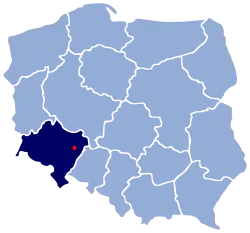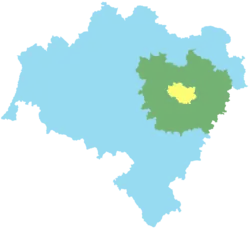Wrocław metropolitan area
Aglomeracja wrocławska Wrocław agglomeration | |
|---|---|
Urban area | |
 Skyline of Wrocław | |
 Location of Wrocław in Poland | |
 Wrocław metropolitan area in green | |
| Country | Poland |
| Voivodeship | Lower Silesian |
| Area | |
| • Land | 3,627 km2 (1,400 sq mi) |
| Population | |
| • Metro | ~1,250,000 |
| • Metro density | 345/km2 (890/sq mi) |
| GDP | |
| • Metro | €15.222 billion (2020) |
| Time zone | UTC+1 (CET) |
| • Summer (DST) | UTC+2 (CEST) |
| Website | aglomeracja |
The Wrocław metropolitan area is a monocentric agglomeration in the south-western part of Poland, in the Lower Silesian Voivodship, consisting of the city of Wrocław (a global Gamma-level metropolis) and its satellite towns. The population living in the agglomeration is about 1,25 million people.
In the case of the Wrocław agglomeration, its area is not strongly urbanized in its entirety. The agglomeration is defined as an area that is economically and geographically linked to Wrocław.
Cities and towns
Data from GUS, with population included (30.06.2023)
 Wrocław – 674,132
Wrocław – 674,132 Oleśnica – 35,210
Oleśnica – 35,210 Oława – 33,183
Oława – 33,183 Jelcz-Laskowice – 15,088
Jelcz-Laskowice – 15,088 Trzebnica – 13,624
Trzebnica – 13,624 Brzeg Dolny – 12,565
Brzeg Dolny – 12,565 Wołów – 12,043
Wołów – 12,043 Strzelin – 11,956
Strzelin – 11,956 Siechnice – 10,797
Siechnice – 10,797 Milicz 10,785
Milicz 10,785- Kiełczów – 10,569
 Syców – 9,928
Syców – 9,928 Środa Śląska – 9,548
Środa Śląska – 9,548 Oborniki Śląskie – 8,992
Oborniki Śląskie – 8,992 Kąty Wrocławskie – 7,171
Kąty Wrocławskie – 7,171 Sobótka – 6,997
Sobótka – 6,997 Twardogóra – 6,207
Twardogóra – 6,207 Żmigród – 6,205
Żmigród – 6,205- Smolec – 5,384
- Bielany Wrocławskie – 4,495
 Bierutów – 4,481
Bierutów – 4,481- Długołęka – 4,127
Development Agency
.png.webp)
In 2005, the city of Wroclaw and seven municipalities set up a company called Agencja Rozwoju Aglomeracji Wrocławskiej SA (ARAW, Wroclaw Agglomeration Development Agency).[3][4] At present, its shareholders include 30 municipalities from the districts:

Economy
In 2021 Wrocław's gross metropolitan product was €15.2 billion. This puts Wrocław in 165th place among cities in European Union.[5]
Wrocław Agglomeration Association

In June 2013, Wroclaw Agglomeration Association was registered, which currently comprises 26 municipalities from the Wroclaw agglomeration area:[6]
See also
References
- ↑ Urban Audit: City Profiles, archived from the original on 2013-10-14
- ↑ "Gross domestic product (GDP) at current market prices by metropolitan regions". ec.europa.eu.
- ↑ Buček, Ján; Ryder, Andrew (2015-04-15). Governance in Transition. Springer. ISBN 978-94-007-5503-1.
- ↑ "Wroclaw Agglomeration Development Agency | Invest in Wrocław". Retrieved 2021-03-31.
- ↑ "EU regions by GDP, Eurostat".
- ↑ "O nas · Aglomeracja Wrocławska". aglomeracja.wroclaw.pl. Retrieved 2021-03-31.